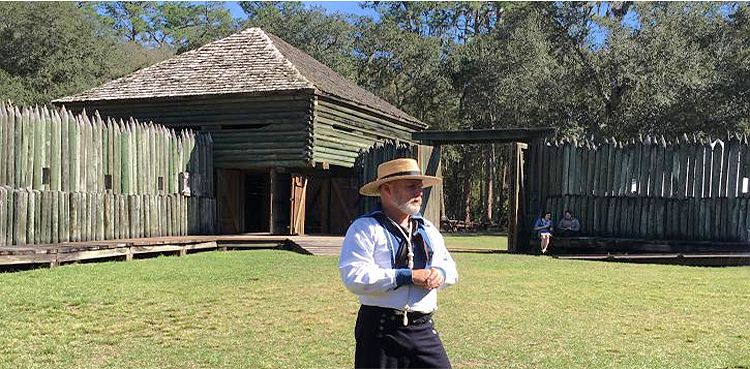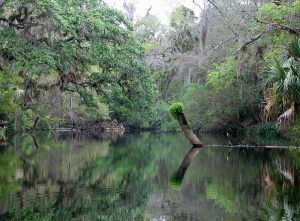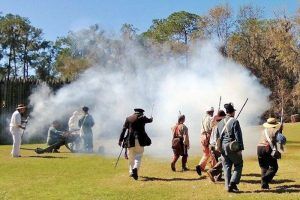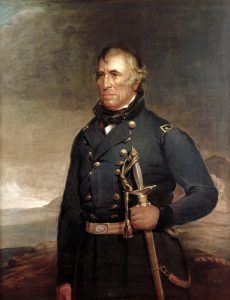
Fort Foster State Historic Site, Florida, courtesy of Florida State Parks
Fort Foster was a U.S. Army post established in present-day Hillsborough County, Florida, in 1836 during the Second Seminole War.
The first fort established at the site was Fort Alabama, built by troops led by Colonel William Lindsay in March 1836. The fort was attacked by a large force of hostile Indians almost immediately and was abandoned in April 1836. It was later destroyed by a booby-trapped keg of gunpowder.
At the end of 1836, orders were issued to reestablish Fort Alabama as a strong picket work with blockhouses at opposing angles. The post was located at a strategic point along the Fort King to Fort Brooke trail at a bridge crossing of the Hillsborough River. A force of 430 soldiers left Fort Brooke on November 30, 1836, to reestablish the fort under the command of Lieutenant Colonel William S. Foster. Their orders were to rebuild the fort and the bridge that had been destroyed months earlier. By December 19, he had erected two blockhouses, a large storehouse, and the fort. By the end of the year, the bridge and powder magazine were completed. Upon inspection, Brevet Major General Thomas S. Jesup declared the work satisfactory and named the new post Fort Foster.

Hillsborough River. Florida courtesy Wikipedia
The fort’s primary purpose was to defend the bridge crossing the Hillsborough River and act as a resupply point for the soldiers in the field. On January 1, 1837, Colonel Foster boasted in a letter to General R. Jones that “the works at Fort Foster on the Hillsborough River …. Fort & Bridge form one of the best and strongest field fortifications ever erected against Indians.”
The armament and supplies at Fort Foster were well stocked, including a six-pounder gun and a howitzer with at least 100 rounds of ammunition for each, 40,000 rounds of rifle powder and bullets, 50,000 ball and buckshot cartridges. There were also 50,000 rations of subsistence and 10,000 bushels of corn. Tools of every description required for service in the field were also stocked at the fort.
The fort was garrisoned on and off from December 1836 thru April 1838. From January 1836 thru March 1837, the fort was garrisoned predominately by sailors. U.S. Navy Lieutenant Thomas J. Lieb, 50 sailors, and 20 artillery soldiers were assigned to defend the fort and bridge.
The fort came under Indian attack and was plagued by sickness and disease. General Jesup lobbied Washington to allow the Indians to remain in south Florida and to close the unhealthy posts. However, he was rebuked by Washington and replaced by General Zachary Taylor.
The worst attack on the fort came in February 1836, when Seminole warriors attempted to set fire to the bridge. However, the Indians were thwarted by aggressive musket and cannon fire from the sailors and the artillerymen. Seminole attacks increased to the point that forced Lieutenant Lieb to send a message to Fort Brooke for reinforcements. In response, 150 Marines were dispatched to Fort Foster to assist the sailors. When the Marines arrived, the Seminole rethought their intentions and fled. That summer, the fort was abandoned because of disease among its forces.
General Taylor ordered the post abandoned in May 1838, but it was reoccupied in December 1841. It was closed again at the end of the Second Seminole War in 1842. It was reopened in 1849 for short periods to meet the needs of the military when Seminole activity threatened.
When the Third Seminole War began in 1855, the post was reoccupied, at which time it was referred to as “Old fort Foster.” A supply depot was opened for the third war one-half mile north of the Fort. It was abandoned for the final time when the war was over and deteriorated.

Fort Foster Reenactment courtesy Crazy Crow Trading Post.
The fort site was added to the National Register of Historic Places in June 1972, and a replica of the fort was constructed by the state and opened in February 1980. It is owned and operated by the Florida State Park system as Fort Foster State Historic Site as part of Hillsborough River State Park. Access to the fort is controlled by park rangers and limited to guided tours on specific days. The Fort Foster State Historic Site is located at 15402 U.S. 301 N. in Thonotosassa, Florida.
© Kathy Alexander/Legends of America, updated November 2022.
Also See:

